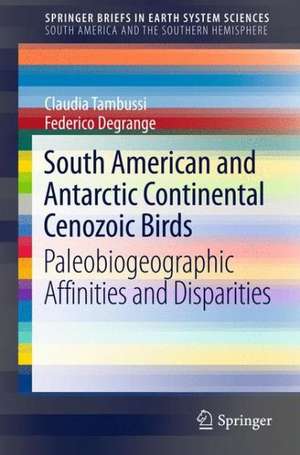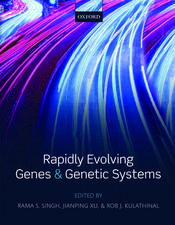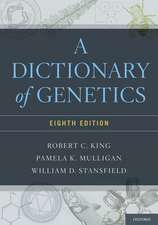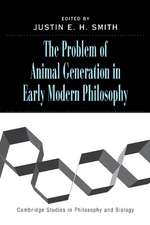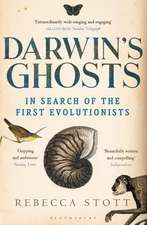South American and Antarctic Continental Cenozoic Birds: Paleobiogeographic Affinities and Disparities: SpringerBriefs in Earth System Sciences
Autor Claudia P. Tambussi, Federico Degrangeen Limba Engleză Paperback – 24 dec 2012
Din seria SpringerBriefs in Earth System Sciences
-
 Preț: 379.09 lei
Preț: 379.09 lei -
 Preț: 260.95 lei
Preț: 260.95 lei -
 Preț: 424.71 lei
Preț: 424.71 lei -
 Preț: 378.54 lei
Preț: 378.54 lei -
 Preț: 380.07 lei
Preț: 380.07 lei -
 Preț: 376.22 lei
Preț: 376.22 lei -
 Preț: 377.57 lei
Preț: 377.57 lei -
 Preț: 379.48 lei
Preț: 379.48 lei -
 Preț: 379.09 lei
Preț: 379.09 lei -
 Preț: 377.35 lei
Preț: 377.35 lei -
 Preț: 379.09 lei
Preț: 379.09 lei -
 Preț: 259.57 lei
Preț: 259.57 lei -
 Preț: 376.80 lei
Preț: 376.80 lei -
 Preț: 377.73 lei
Preț: 377.73 lei -
 Preț: 379.86 lei
Preț: 379.86 lei -
 Preț: 381.00 lei
Preț: 381.00 lei -
 Preț: 140.77 lei
Preț: 140.77 lei -
 Preț: 380.07 lei
Preț: 380.07 lei -
 Preț: 262.47 lei
Preț: 262.47 lei -
 Preț: 377.18 lei
Preț: 377.18 lei -
 Preț: 260.56 lei
Preț: 260.56 lei -
 Preț: 376.22 lei
Preț: 376.22 lei -
 Preț: 377.18 lei
Preț: 377.18 lei -
 Preț: 348.79 lei
Preț: 348.79 lei -
 Preț: 378.12 lei
Preț: 378.12 lei -
 Preț: 379.09 lei
Preț: 379.09 lei -
 Preț: 376.59 lei
Preț: 376.59 lei -
 Preț: 375.23 lei
Preț: 375.23 lei -
 Preț: 376.04 lei
Preț: 376.04 lei -
 Preț: 380.07 lei
Preț: 380.07 lei -
 Preț: 443.58 lei
Preț: 443.58 lei -
 Preț: 384.48 lei
Preț: 384.48 lei -
 Preț: 377.95 lei
Preț: 377.95 lei -
 Preț: 376.59 lei
Preț: 376.59 lei -
 Preț: 350.18 lei
Preț: 350.18 lei -
 Preț: 379.68 lei
Preț: 379.68 lei -
 Preț: 378.71 lei
Preț: 378.71 lei -
 Preț: 376.96 lei
Preț: 376.96 lei -
 Preț: 377.35 lei
Preț: 377.35 lei -
 Preț: 374.30 lei
Preț: 374.30 lei -
 Preț: 377.73 lei
Preț: 377.73 lei -
 Preț: 378.34 lei
Preț: 378.34 lei -
 Preț: 378.54 lei
Preț: 378.54 lei -
 Preț: 412.89 lei
Preț: 412.89 lei -
 Preț: 375.62 lei
Preț: 375.62 lei -
 Preț: 341.97 lei
Preț: 341.97 lei -
 Preț: 379.09 lei
Preț: 379.09 lei -
 Preț: 375.23 lei
Preț: 375.23 lei -
 Preț: 377.35 lei
Preț: 377.35 lei
Preț: 378.12 lei
Nou
Puncte Express: 567
Preț estimativ în valută:
72.36€ • 75.27$ • 59.74£
72.36€ • 75.27$ • 59.74£
Carte tipărită la comandă
Livrare economică 14-28 aprilie
Preluare comenzi: 021 569.72.76
Specificații
ISBN-13: 9789400754669
ISBN-10: 9400754663
Pagini: 128
Ilustrații: XI, 113 p. 23 illus., 7 illus. in color.
Dimensiuni: 155 x 235 x 7 mm
Greutate: 0.18 kg
Ediția:2013
Editura: SPRINGER NETHERLANDS
Colecția Springer
Seria SpringerBriefs in Earth System Sciences
Locul publicării:Dordrecht, Netherlands
ISBN-10: 9400754663
Pagini: 128
Ilustrații: XI, 113 p. 23 illus., 7 illus. in color.
Dimensiuni: 155 x 235 x 7 mm
Greutate: 0.18 kg
Ediția:2013
Editura: SPRINGER NETHERLANDS
Colecția Springer
Seria SpringerBriefs in Earth System Sciences
Locul publicării:Dordrecht, Netherlands
Public țintă
ResearchCuprins
Introduction.- Paleogeograpic background.- Geological settings of the major fossil localities in South America and Antarctica.- The nature of the bird fossil record.- The Paleogene birds of South America.- Eocene birds from Antarctica and their relationships with those of South America.- The Neogene birds of South America.- The dominance of zoophagous birds.- Bioconections of South America and other continents: What is and what is not possible to conclude.
Notă biografică
Claudia P. Tambussi has a PhD in Natural Science (Universidad Nacional de La Plata, UNLP) and is Coordinator of La Plata Museum Education Office. She is a Researcher of CONICET (Consejo Nacional de Investigaciones Científicas y Técnicas) performing tasks in paleobiology and evolution of South American and Antarctic birds at La Plata Museum. She is a member of the editorial staff of the MUSEO Journal. She has written two popular science books, (co-)written over 60 scientific papers and contributed to textbooks of Natural Sciences.
Federico J. Degrange has a License in Biology, with orientation on paleontology, obtained at La Plata University. He is a member of CONICET, and an advanced PhD student in Natural Sciences, working on paleobiology of South American carnivorous birds at La Plata Museum. He is teaching comparative vertebrate anatomy at UNLP. He is (co-)author of seven scientific papers.
Federico J. Degrange has a License in Biology, with orientation on paleontology, obtained at La Plata University. He is a member of CONICET, and an advanced PhD student in Natural Sciences, working on paleobiology of South American carnivorous birds at La Plata Museum. He is teaching comparative vertebrate anatomy at UNLP. He is (co-)author of seven scientific papers.
Textul de pe ultima copertă
Modern birds (Neornithes) are represented by two big lineages, the Palaeognathae (Tinamiformes + Ratitae) and the Neognathae [Galloanserae + Neoaves (Metaves + Coronoaves)]. Both clades sum approximately 10,000 species of which 60% are Passeriformes (the most diverse clade of terrestrial vertebrates). A comparison between the past and the present reveals a complex and hallmarked evolutionary and biogeographic history which would have begun over 65 million years ago. For South America (SA) this includes: (1) the presence of taxa with uncertain affinities and the absence of Passeriformes during the Paleogene; (2) a progressive and accelerated increase of the species starting at the Neogene (Miocene); (3) important extinct lineages (e.g. Phorusrhacidae, Teratornithidae) that migrate to North America after the rising of the Panamá isthmus; (4) groups with major diversification in the Neogene that survives nowadays represented by scarce species endemic of SA (Cariamidae) or that inhabits mainly in the southern hemisphere (Anhingidae); (5) very diverse living groups with scarce (e.g., Passeriformes) or none (e.g., Apodiformes) fossil record in SA, which stem-groups are registered in Europe. Apparently, the changes in diversity of the south American Neornithes have been the result of successive radiation, biogeographic connections with North America and in a minor scale, some extinctions. The opening of the Drake´s passage and the occurrence of the circumpolar Antarctic flow are not sufficient causes to explain the highly disparity between the weddelians penguins (Sphenisciformes) of Antartica and those of the patagonian Atlantic Ocean.
Caracteristici
Includes supplementary material: sn.pub/extras
